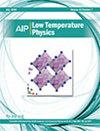War-derived air pollution nanohybrids and their membrane-active properties
IF 0.8
4区 物理与天体物理
Q4 PHYSICS, APPLIED
引用次数: 0
Abstract
Hostilities are accompanied by extremely enhanced air pollution with particulate matter (PM) which was exactly shown in Ukraine, where increased PM2.5 (the size less than 2.5 μm) correlated with war activities [R. Zalakeviciute et al., Sustainability 14(21), 13832 (2022)]. Drastic increases in PM2.5 pollution from bombing and structural fires raise additional health concerns. Also, the widest spread of war-associated metal pollutants are copper and iron [Metal Pollutants Associated with War <https://ecopolitic.com.ua> (2023, November)] which are neurotoxic [B. Tarnacka et al., Int. J. Mol. Sci. 22(15), 7820 (2021)]. Calculations have revealed that Ukrainian regions are highly contaminated with copper and iron that in turn become bioavailable. Neurological disorders are the most common cause of disability/death and their increase is linked to air pollution with PM, which targets the nervous system triggering the development of neuropathology as shown in the epidemiological data of the Lancet Commission [P. J. Landrigan et al., Lancet 391, 462 (2018)]. Airborne PM can travel across state boundaries, oceans, and continents, and so disperses globally causing hazards to human health not only in Ukraine but also worldwide. Our hypothesis [T. Borisova, N. Krisanova, O. Gnatiuk, V. Boyko, and G. Dovbeshko, Project “War-derived air pollution nanohybrids composed of carbon-containing smoke nanoparticles and metal compounds: FTIR/Raman spectroscopic, fluorescent and membrane-active properties, their potential neurotoxicity and its prevention”, PAN.BFB.S.BWZ.380.022.2023] is that the neurotoxic potential of abandoned war-associated carbonaceous smoke nanoparticles can be significantly enhanced by copper and iron compounds during their combined release to the environment during bombing and fires. Moreover, they can form nanohybrids during interaction in the environment. This hypothesis is based on our recent experimental data regarding neurotoxic features of smoke PM from wood and plastics and their capability to interact with other pollutants [A. Borysov et al., Environ. Pollut. 263, 114502 (2020), A. Pastukhov et al., Sci. Rep. 13, 17771 (2023), T. Borisova, Environmental Nanoparticles: Focus on Multipollutant Strategy for Environmental Quality and Health Risk Estimations, Chapter in: Biomedical Nanomaterials, R. S. Stoika (ed.) (2021), pp. 305–321, T. Borisova and S. Komisarenko Environ Sci. Pollut. Res. 28(30), 40371 (2021)]. It is an urgent necessity to analyze the molecular structure and membrane-active properties of war-derived polluted nanohybrids composed of carbonaceous smoke nanoparticles, copper, and iron; to assess their potential neurotoxicity and to find a way of neuroprotection. Knowledge about the capability of different war-derived PM to form environmental nanohybrids with war-associated pollutant copper and iron, and their spectroscopic, fluorescent, and membrane-active features can be applicable in environmental monitoring. Potential neurotoxicity data of war-derived nanohybrids can be used for the prognosis of neurological symptoms and the development of possible ways for neuroprotection.源自战争的空气污染纳米混合物及其膜活性特性
在乌克兰,PM2.5(小于 2.5 μm)的增加与战争活动有关[R. Zalakeviciute 等人,《可持续性》14(21),13832(2022 年)]。轰炸和结构性火灾导致 PM2.5 污染急剧增加,引发了更多的健康问题。此外,与战争相关的金属污染物中传播最广的是铜和铁[Metal Pollutants Associated with War <https://ecopolitic.com.ua> (2023, November)],它们具有神经毒性[B. Tarnacka et al., Int. J. Mol. Sci.计算显示,乌克兰地区受到铜和铁的高度污染,而铜和铁又可被生物利用。神经系统疾病是导致残疾/死亡的最常见原因,其增加与空气中的可吸入颗粒物污染有关,正如柳叶刀委员会的流行病学数据所示,可吸入颗粒物针对神经系统,引发神经病理学的发展[P. J. Landrigan 等人,Lancet 391, 462 (2018)]。空气中的可吸入颗粒物可以跨越国界、海洋和大陆,因此在全球范围内扩散,不仅在乌克兰,而且在全球范围内对人类健康造成危害。我们的假设 [T.Borisova, N. Krisanova, O. Gnatiuk, V. Boyko, and G. Dovbeshko, Project "War-derived air pollution nanohybrids composed of carboncontaining smoke nanoparticles and metal compounds:PAN.BFB.S.BWZ.380.022.2023] 认为,在轰炸和火灾期间,被遗弃的与战争有关的碳质烟雾纳米粒子在向环境中联合释放时,铜和铁化合物可显著增强其神经毒性潜能。此外,它们在环境中相互作用时还会形成纳米混合物。这一假设是根据我们最近关于木材和塑料烟雾微粒的神经毒性特征及其与其他污染物相互作用能力的实验数据提出的[A. Borysov et al.Borysov 等人,Environ.Pollut.263, 114502 (2020), A. Pastukhov et al., Sci. Rep. 13, 17771 (2023), T. Borisova, Environmental Nanoparticles:Focus on Multipollutant Strategy for Environmental Quality and Health Risk Estimations, Chapter in:Biomedical Nanomaterials, R. S. Stoika (ed.) (2021), pp.28(30), 40371 (2021)]。当务之急是分析由碳质烟雾纳米粒子、铜和铁组成的战争污染纳米混合物的分子结构和膜活性特性;评估其潜在的神经毒性并找到神经保护方法。了解不同的战争衍生可吸入颗粒物与战争相关污染物铜和铁形成环境纳米杂化物的能力,以及它们的光谱、荧光和膜活性特征,可用于环境监测。战争衍生纳米杂化物的潜在神经毒性数据可用于神经症状的预后和神经保护方法的开发。
本文章由计算机程序翻译,如有差异,请以英文原文为准。
求助全文
约1分钟内获得全文
求助全文
来源期刊

Low Temperature Physics
物理-物理:应用
CiteScore
1.20
自引率
25.00%
发文量
138
审稿时长
3 months
期刊介绍:
Guided by an international editorial board, Low Temperature Physics (LTP) communicates the results of important experimental and theoretical studies conducted at low temperatures. LTP offers key work in such areas as superconductivity, magnetism, lattice dynamics, quantum liquids and crystals, cryocrystals, low-dimensional and disordered systems, electronic properties of normal metals and alloys, and critical phenomena. The journal publishes original articles on new experimental and theoretical results as well as review articles, brief communications, memoirs, and biographies.
Low Temperature Physics, a translation of the copyrighted Journal FIZIKA NIZKIKH TEMPERATUR, is a monthly journal containing English reports of current research in the field of the low temperature physics. The translation began with the 1975 issues. One volume is published annually beginning with the January issues.
 求助内容:
求助内容: 应助结果提醒方式:
应助结果提醒方式:


